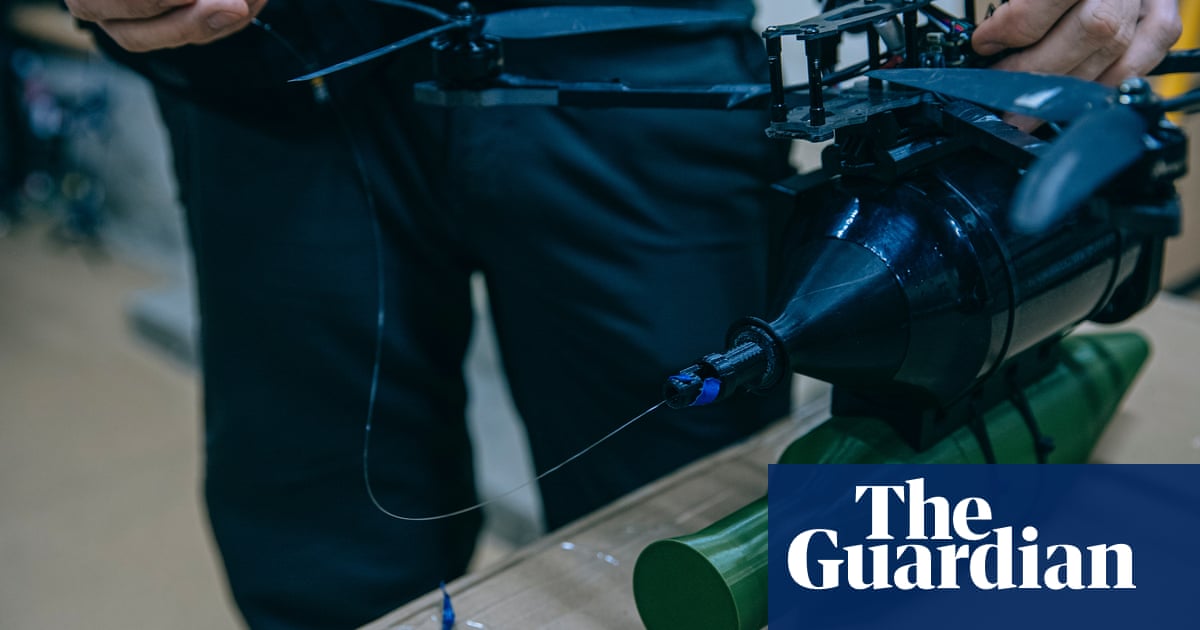At a secret workshop in Ukraine’s north-east, where about 20 people assemble hundreds of FPV (first person view) drones, there is a new design. Under the frame of the familiar quadcopter is a cylinder, the size of a forearm. Coiled up inside is fibre optic cable, 10km (6 miles) or even 20km long, to create a wired kamikaze drone.
Capt Yuriy Fedorenko, the commander of a specialist drone unit, the Achilles regiment, says fibre optic drones were an experimental response to battlefield jamming and rapidly took off late last year. With no radio connection, they cannot be jammed, are difficult to detect and able to fly in ways conventional FPV drones cannot.
“If pilots are experienced, they can fly these drones very low and between the trees in a forest or tree line. If you are flying with a regular drone, the trees block the signal unless you have a re-transmitter close,” he observes. Where tree lined supply roads were thought safer, fibre optic drones have been able to get through.
Wouldn’t the fiber lead directly back to the pilot, though? You’d have to constantly be moving locations, otherwise they could just follow the wire.
Edit: I know, I know, the more I’ve thought about it–and despite them actually proving it’s possible to do as mentioned in the article–it’s just not very practical to do in many situations. As one commenter mentioned below, after seeing pictures of some trees, numerous drones create a web among trees/bushes/etc. So tracing lines when drones are launched from multiple locations would be extremely difficult and they could even set up ambushed at certain points if they saw enemy scouts doing it.
It’s real long, like miles of fairly small transparent cable.
If they’re up to 20 km it could take you a while and they’re very small and difficult to see, possibly going through difficult terrain.
Plus, by the time you find the end, the crew can have moved on.
You could also exploit that to ambush the people trying to follow the cable farther into enemy territory.
Also, assuming the Ops are closer than the max length of the cable, you can fly it in circles or backtracks to make tracing it that much harder.
You won’t be able to just follow the wire, it’s millimeter thin and extremely light. And drone operators need to constantly move anyway.
And drone operators need to constantly move anyway.
It’s probably not required if not using RF.
From the article :
There are examples of drone operators from earlier this year being able to trace the cables back to the positions from where they were launched and target the enemy crews. But if this technique was a successful one, fibre optic drones would have disappeared as soon as they appeared on the battlefield, when – from presidents to workshops – all the talk is of increasing numbers.
Perhaps they just pull it back real fast 😆
I was thinking the same thing! If it’s a super small cable (1mm diameter) couldn’t they have some sort of auto winch that pulled the line back after detonation? I’m not an engineer, so I’d obviously defer to an expert on this.
Primary issues I can see with retrieval are tangling/kinking and re-spooling/splicing. The fibers are insanely thin and the drones are flying in between trees, not exactly a smooth path for retrieval.
I saw a picture a few weeks ago of a field in Ukraine, taken from amongst an adjacent patch of trees, and it just looks like spiderwebs. Dozens and dozens of fine spider web strands, each one delivering a drone into the meat grinder. Terrible, beautiful, and such a fucking waste.
What are all those glass fibers going to do to an area after the war ends? That stuff won’t decompose.
It’s also not going to explode so probably less of an issue on the whole than all the UXO there…
I live in an area where fires are frequent and aerial cables plentiful.
Once in a while, a crew comes around and picks up all the broken cable. But considering these are mostly glass, non insulated cables, I’d risk it just becomes another inert part of the soil.
Hopefully, there will be a retrieval plan, after all the madness ends.
Fibre glass is essentially silica fibres with a trace amount of metal to make the fibre glass act the way it does. Guess what sand is also made of, silica with trace amounts of impurities. So when they break down it’ll just be sand in the end. Not ‘decomposable’ but quite friendly to the environment still.
Yes, that is obvious. I’m not worried about chemical contamination. Physical contamination and injury is the problem. I’m much more worried about civilians interacting with an environment saturated with these things. A kid is riding a dirt bike through the woods one day and gets garroted on an invisible glass wire dangling between two trees.
Ahh I wasn’t really thinking of the injury implications. In terms of after war cleanup and decades on effects to civilians I didn’t think it was a problem. At least clean up efforts would be simple enough with just a good pair of gloves and side cutters.
You’ve obviously never embedded a piece of fibre optic cable in your skin. It’s very sharp and will break off inside. It’s not exactly life threatening, but it hurts like a bitch and can be really hard to find and remove.
I’ve stabbed myself with fibre optic and I do agree, it’s not nice, a lot better than unexploded ordanance though so I didn’t think of the injury implications.
- wire spool is located on the drone itself not the other way around
- You can’t pull it back it’s all tangled up
- Wires are very hard to see
Couldn’t they just make it standard practice to reel in the wire after detonation? Sure, it could snap, but that would still be only partial direction information.
I assume there are ways of doible backing in some unexpected direction first before flying out of one thicket into another and maybe then to the enemy? I am just guessing what is practical though
Huh, I remember one of the few draw backs of fiber optic cables being that you had to be very careful with them, because bending them could easily cause them to crack and no longer work. I’m guessing that must no longer be an issue!
The fiber we use at our datacenter is quite flexible but still gets damaged if you bend it too far. To roll it like they describe you would still want to have a fairly large drum (probably like 3-4 inches in diameter) which would make it pretty bulky for a small drone.
They literally describe it as “the size of a forearm” so that about tracks with 3-4 inches diameter.
“Secret workshop”? Why are they talking openly to the press then?
Because the secret is where it is, not that it exists.
Why talk about it at all though? What military benefits from telling the press about its newest weapons?
The tech itself isn’t secret, both sides use it. With Russia being ahead apparently. From the article:
A video from a Russian military Telegram channel from last month demonstrates their ominous capability. A fibre optic drone, the nose of the yellow cylinder housing the coil clearly visible, flies with precision a few centimetres from the ground, to strike a Ukrainian howitzer concealed in a barn, a location clearly previously considered safe.
But as Fedorenko acknowledges, it is Russia that, at least for now, “is well ahead of us” – largely because Moscow has had greater access to fibre optic cabling, with Ukraine scrambling to catch up.
Y’all answering “what” to a “why” question.




